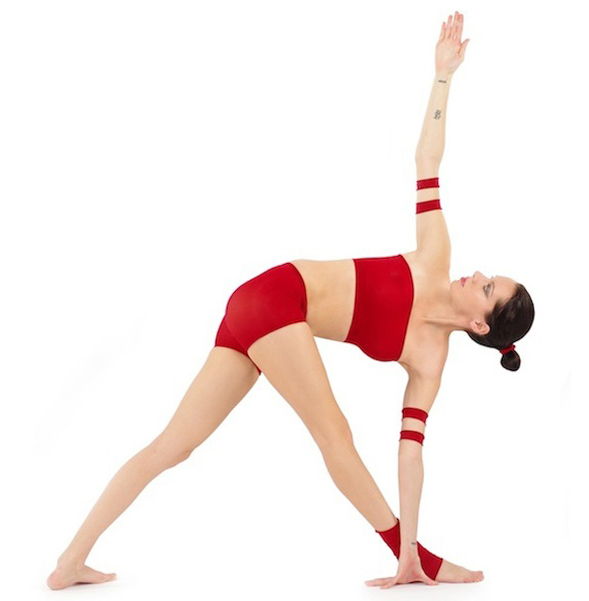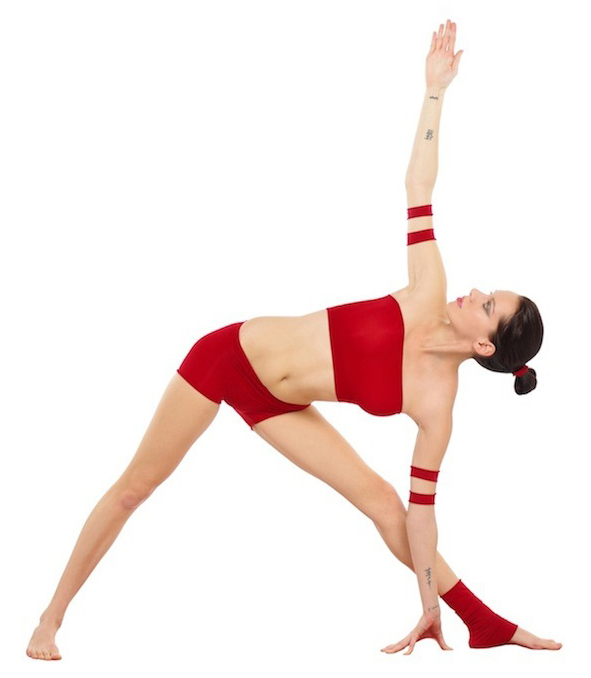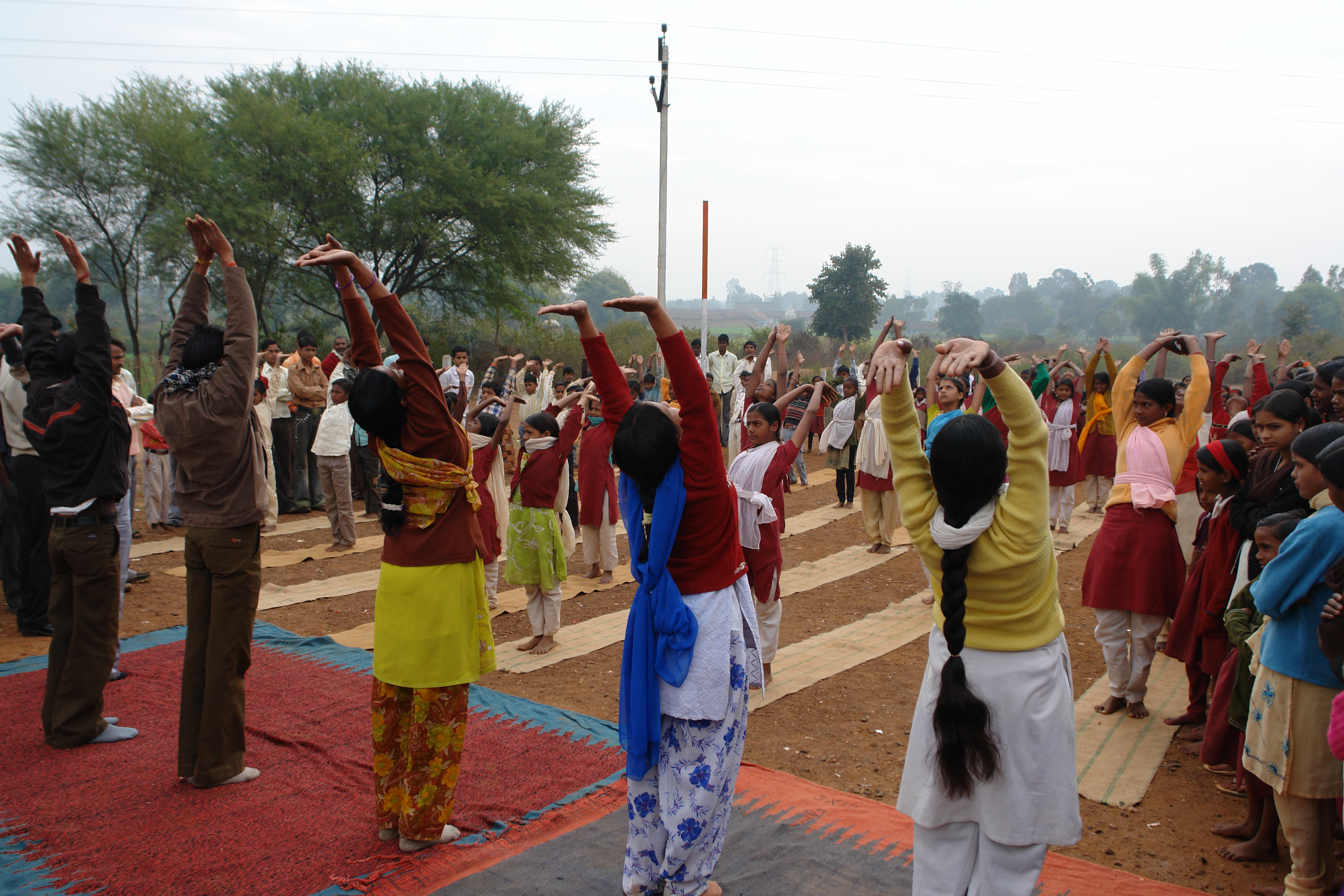|
Drishti (yoga)
Drishti (, , "focused gaze") is a means for developing concentrated intention. It relates to the fifth limb of yoga, pratyahara, concerning sense withdrawal, as well as the sixth limb, dharana, relating to concentration. In Ashtanga Vinyasa Yoga, each asana is associated with one of the 8 focused gazes, namely Angusthamadhye (thumb), Bhrumadhye (eyebrow), Nasagre (tip of nose), Hastagrahe (tips of hands), Parshva (side), Urdhva (up), Nabhicakre (navel), and Padayoragre (tips of feet) Drishtis. In some other styles such as Sivananda Yoga, less use is made of the gaze, and fewer types are employed. History The ''Yoga Sutras of Patanjali'' define eight limbs of yoga but do not mention the gaze. The sixth limb, dharana (concentration), however requires holding one's mind onto an inner state, subject or topic. The mind can for example be fixed on a mantra, one's breath, or a part of the body such as the navel or the tip of the tongue. This is an internal concentration of atten ... [...More Info...] [...Related Items...] OR: [Wikipedia] [Google] [Baidu] |
Ashtanga (eight Limbs Of Yoga)
Ashtanga yoga (, "eight limbs of yoga") is Patanjali, Pātañjali's classification of classical yoga, as set out in his ''Yoga Sutras of Patanjali, Yoga Sūtras''. He defined the eight limbs as ''Yamas, yama'' (abstinences), ''niyama'' (observances), ''Asana, āsana'' (postures), ''Pranayama, prāṇāyāma'' (breath control), ''Pratyahara, pratyāhāra'' (withdrawal of the senses), ''dhāraṇā'' (concentration), ''Dhyana in Hinduism, dhyāna'' (meditation), and ''Samadhi, samādhi'' (absorption). The eight limbs form a sequence from the outer to the inner. The posture, asana, must be steady and comfortable for a long time, in order for the yogi to practice the limbs from ''Pranayama, prāṇāyāma'' until ''Samadhi, samādhi''. The main aim is ''kaivalya'', discernment of ''Purusha, Puruṣa'', the witness-conscious, as separate from ''Prakṛti'', the cognitive apparatus, and disentanglement of ''Puruṣa'' from its muddled defilements. Definition of yoga Patanjali, Pā ... [...More Info...] [...Related Items...] OR: [Wikipedia] [Google] [Baidu] |
Surya Namaskar
Sun Salutation, also called Surya Namaskar or Salute to the Sun (, ), is a practice in yoga as exercise incorporating a flow sequence of some twelve linked asanas. The asana sequence was first recorded as yoga in the early 20th century, though similar exercises were in use in India before that, for example Indian wrestling, among wrestlers. The basic sequence involves moving from a standing position into Downward dog, Downward and Upward Dog poses and then back to the standing position, but many variations are possible. The set of 12 asanas is dedicated to the Hinduism, Hindu solar deity, Surya. In some Indian traditions, the positions are each associated with a different mantra, and with seed sounds or bīja. The precise origins of the Sun Salutation are uncertain, but the sequence was made popular in the early 20th century by Bhawanrao Shriniwasrao Pant Pratinidhi, the Rajah of Aundh State, Aundh, and adopted into yoga by Krishnamacharya in the Mysore Palace, where the Sun Salu ... [...More Info...] [...Related Items...] OR: [Wikipedia] [Google] [Baidu] |
Parivritta Trikonasana
Trikonasana or Utthita Trikonasana (; ), xtendedTriangle Pose is a standing asana in modern yoga as exercise. Variations include Baddha Trikonasana (bound triangle pose) and Parivrtta Trikonasana (revolved triangle pose). Etymology and origins The name comes from the Sanskrit words (), "extended", () "triangle", and () "posture" or "seat". The pose is first described in the 20th century, appearing in the teaching of Tirumalai Krishnamacharya, including his 1934 book ''Yoga Makaranda'', and in the works of his students. Description Trikonasana is performed in two parts, facing left, and then facing right. The practitioner begins standing with the feet one leg-length apart, knees unbent, turns the right foot completely to the outside and the left foot less than 45 degrees to the inside, keeping the heels in line with the hips. The arms are spread out to the sides, parallel to the ground, palms facing down; the trunk is extended as far as is comfortable to the right, while ... [...More Info...] [...Related Items...] OR: [Wikipedia] [Google] [Baidu] |
Utthita Trikonasana
Trikonasana or Utthita Trikonasana (; ), xtendedTriangle Pose is a standing asana in modern yoga as exercise. Variations include Baddha Trikonasana (bound triangle pose) and Parivrtta Trikonasana (revolved triangle pose). Etymology and origins The name comes from the Sanskrit words (), "extended", () "triangle", and () "posture" or "seat". The pose is first described in the 20th century, appearing in the teaching of Tirumalai Krishnamacharya, including his 1934 book ''Yoga Makaranda'', and in the works of his students. Description Trikonasana is performed in two parts, facing left, and then facing right. The practitioner begins standing with the feet one leg-length apart, knees unbent, turns the right foot completely to the outside and the left foot less than 45 degrees to the inside, keeping the heels in line with the hips. The arms are spread out to the sides, parallel to the ground, palms facing down; the trunk is extended as far as is comfortable to the right, whi ... [...More Info...] [...Related Items...] OR: [Wikipedia] [Google] [Baidu] |
Virabhadrasana
Virabhadrasana (; ) or Warrior Pose is a group of related lunging standing asanas in modern yoga as exercise commemorating the exploits of a mythical warrior, Virabhadra. The name of the pose derives from the Hindu myth, but the pose is not recorded in the hatha yoga tradition until the 20th century. Virabhadrasana has some similarity with poses in the gymnastics of Niels Bukh the early 20th century; it has been suggested that it was adopted into yoga from the tradition of physical culture in India at that time, which was influenced by European gymnastics. Virabhadrasana has been described as one of the most iconic poses in yoga. Etymology and origins The name is from the Sanskrit ''Vīrabhadra'', a mythical warrior, and , a yoga posture or meditation seat. Accordingly the asana is often called "Warrior Pose" in English. Ancient cave rock sculptures in the Ellora Caves, specifically cave 16 and cave 29, show a warrior-Shiva figure in a pose somewhat resembling Virabhadrās ... [...More Info...] [...Related Items...] OR: [Wikipedia] [Google] [Baidu] |
Chaturanga Dandasana
Chaturanga Dandasana (; ) or Four-Limbed Staff pose, also known as Low Plank, is an asana in modern yoga as exercise and in some forms of Surya Namaskar (Salute to the Sun), in which a straight body parallel to the ground is supported by the toes and palms, with elbows at a right angle along the body. The variation Kumbhakasana, Phalakasana, or High Plank has the arms straight. Etymology and origins The name comes from the , "four"; , "limb"; , "staff"; and ; , "posture" or "seat". The pose was unknown in hatha yoga until the 20th century '' Light on Yoga'', but the pose appears in the 1896 ''Vyayama Dipika'', a manual of gymnastics, as part of the "very old" sequence of ''danda'' exercises. The historian of yoga Norman Sjoman suggests that it is one of the poses adopted into yoga as exercise in Mysore by Krishnamacharya and forming the "primary foundation" for his vinyasas with flowing movements between poses. The pose would then have been taken up by his pupils Pattabh ... [...More Info...] [...Related Items...] OR: [Wikipedia] [Google] [Baidu] |
Tadasana
Tadasana (), Mountain pose or Samasthiti (; ) is a standing asana in modern yoga as exercise; it is not described in medieval hatha yoga texts. It is the basis for several other standing asanas. Etymology and origins Tāḍāsana is from the Sanskrit words , "mountain" and meaning "posture" or "seat". Samasthitiḥ is from meaning "equal", level", or "balanced"; and , "standing". The pose was unknown in hatha yoga until the 20th century '' Light on Yoga'', but it appears in the 1896 ''Vyayama Dipika'', a manual of gymnastics, as part of the "very old" sequence of ''danda'' (Sanskrit for "staff" or "stick") exercises. Norman Sjoman suggests that it was among the poses adopted into modern yoga as exercise in Mysore by Krishnamacharya to form the "primary foundation" for his vinyasas with flowing movements between poses. The pose was then taken up by his pupils Pattabhi Jois and B. K. S. Iyengar, into their worldwide Ashtanga (vinyasa) yoga and Iyengar Yoga styles resp ... [...More Info...] [...Related Items...] OR: [Wikipedia] [Google] [Baidu] |
Surya Namaskara
Sun Salutation, also called Surya Namaskar or Salute to the Sun (, ), is a practice in yoga as exercise incorporating a flow sequence of some twelve linked asanas. The asana sequence was first recorded as yoga in the early 20th century, though similar exercises were in use in India before that, for example among wrestlers. The basic sequence involves moving from a standing position into Downward and Upward Dog poses and then back to the standing position, but many variations are possible. The set of 12 asanas is dedicated to the Hindu solar deity, Surya. In some Indian traditions, the positions are each associated with a different mantra, and with seed sounds or bīja. The precise origins of the Sun Salutation are uncertain, but the sequence was made popular in the early 20th century by Bhawanrao Shriniwasrao Pant Pratinidhi, the Rajah of Aundh, and adopted into yoga by Krishnamacharya in the Mysore Palace, where the Sun Salutation classes, not then considered to be yoga, we ... [...More Info...] [...Related Items...] OR: [Wikipedia] [Google] [Baidu] |
Adho Mukha Svanasana
Downward Dog Pose, Downward-facing Dog Pose, or Downdog, also called Adho Mukha Svanasana (; ), is an inversion asana in yoga as exercise. It is often practised as part of a flowing sequence of poses, especially Surya Namaskar, the Salute to the Sun. The asana does not have formally named variations, but several playful variants are used to assist beginning practitioners to become comfortable in the pose. Downward Dog stretches the hamstring and calf muscles in the backs of the legs, and builds strength in the shoulders. Some popular sites have advised against it during pregnancy, but an experimental study of pregnant women found it beneficial. Downward Dog has been called "deservedly one of yoga's most widely recognized yoga poses" and the "quintessential yoga pose". As such it is often the asana of choice when yoga is depicted in film, literature, and advertising. The pose has frequently appeared in Western culture, including in the titles of novels, a painting, and a televi ... [...More Info...] [...Related Items...] OR: [Wikipedia] [Google] [Baidu] |
Urdhva Mukha Svanasana
Cobra Pose or Bhujangasana (; IAST: ) is a reclining back-bending asana in hatha yoga and modern yoga as exercise. It is also performed in a cycle of asanas in Surya Namaskar, Salute to the Sun, as an alternative to Urdhva Mukha Svanasana, Upward Dog Pose. The Yin Yoga form is Sphinx Pose. Etymology and origins The name Bhujangasana comes from the Sanskrit words , "snake" and आसन ''āsana'', "posture" or "seat", from the resemblance to a snake with its head raised; it was described in the 17th century hatha yoga text ''Gheranda Samhita'' in chapter 2, verses 42–43. In the 19th century '' Sritattvanidhi'', the pose is named सरपासन ''Sarpāsana'', "Serpent Pose", from , , "serpent" or "snake". Yogi Narayana Ghamande described and illustrated the pose in halftone as Bhujangasana in the 1905 '' Yogasopana Purvacatuska''. Urdhva Mukha Shvanasana ( IAST: ) is from the Sanskrit , "upwards"; , "face"; and , "dog". The pose is one of those (along with Downward D ... [...More Info...] [...Related Items...] OR: [Wikipedia] [Google] [Baidu] |
Uttanasana
Uttanasana (; ) or Standing Forward Bend, with variants such as Padahastasana where the toes are grasped, is a standing forward bending asana in modern yoga as exercise. Etymology and origins The name comes from the Sanskrit words , "intense stretch"; and ; , "posture" or "seat". The pose is a modern one, first seen in the 20th century. A pose with the name Uttānāsana is illustrated in the 19th century ''Sritattvanidhi'' but it is quite different from the modern pose (lying on the back, with elbows touching the knees and the hands behind the neck). The modern pose is described in Krishnamacharya's 1934 ''Yoga Makaranda'', and in the works of his pupils, B. K. S. Iyengar's 1966 ''Light on Yoga'' and Pattabhi Jois's Ashtanga (vinyasa) yoga. Theos Bernard however illustrates the related pose "Padhahasthasana" (sic) in his 1944 report of his experience of hatha yoga on the border of India and Tibet, suggesting the existence of a separate tradition. Description The pose is ent ... [...More Info...] [...Related Items...] OR: [Wikipedia] [Google] [Baidu] |
Virabhadrasana A
Virabhadrasana (; ) or Warrior Pose is a group of related lunging standing asanas in modern yoga as exercise commemorating the exploits of a mythical warrior, Virabhadra. The name of the pose derives from the Hindu myth, but the pose is not recorded in the hatha yoga tradition until the 20th century. Virabhadrasana has some similarity with poses in the gymnastics of Niels Bukh the early 20th century; it has been suggested that it was adopted into yoga from the tradition of physical culture in India at that time, which was influenced by European gymnastics. Virabhadrasana has been described as one of the most iconic poses in yoga. Etymology and origins The name is from the Sanskrit ''Vīrabhadra'', a mythical warrior, and , a yoga posture or meditation seat. Accordingly the asana is often called "Warrior Pose" in English. Ancient cave rock sculptures in the Ellora Caves, specifically cave 16 and cave 29, show a warrior-Shiva figure in a pose somewhat resembling Virabhadrās ... [...More Info...] [...Related Items...] OR: [Wikipedia] [Google] [Baidu] |










